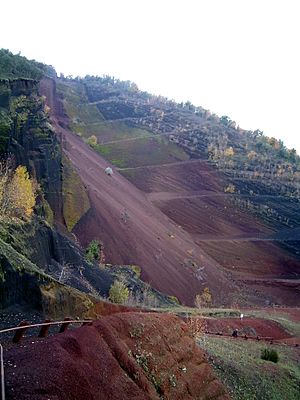Croscat facts for kids
Quick facts for kids Croscat |
|
|---|---|

Aerial view of the Croscat volcano
|
|
| Highest point | |
| Elevation | 786 m (2,579 ft) |
| Geography | |
| Parent range | Catalan Transversal Range |
| Geology | |
| Volcanic arc/belt | Garrotxa Volcanic Field |
| Last eruption | 11,500 years ago |
The Croscat (Catalan pronunciation: [kɾusˈkat]) is a volcano found in the region of Garrotxa, Catalonia, Spain. It is the youngest and tallest volcano in the Iberian Peninsula. Its last eruption happened about 14,000 years ago. The volcano's cone looks like a horseshoe. Part of its side was dug up for volcanic gravel until the early 1990s. This digging showed the inside of the volcano from top to bottom. Croscat is located in the Garrotxa volcanic field, which is a protected area.
How Croscat Formed
The Croscat volcano cone is about 189 meters (620 feet) tall. Its base is shaped like an oval and a horseshoe. This special shape likely happened because lava flowed out from the western side of the volcano during its last eruption.
Scientists studied the Croscat and Santa Margarida Volcano in 2011. They found that both volcanoes were created by the same eruption event. This happened about 11,500 years ago. The eruption involved both water and magma mixing, and also just magma flowing out.
Croscat and People
Starting in the 1960s, people began digging up the northeastern side of the Croscat volcano. They were looking for a type of gravel called lapilli. This digging, and damage to other volcanoes in the Garrotxa Volcanic Field, made many people upset. In the 1970s, a group started protesting to protect the volcanoes. This campaign was called Save the Volcanoes (Catalan: Salvem els Volcans).
The area where they dug was also used as a place to dump trash from the city of Olot. In 1982, the Zona Volcànica de la Garrotxa Natural Park was created to protect the area. However, the digging continued for another nine years. More protests happened when the company digging, Minas de Olot, SA, made a deal. They agreed to dig up 2.7 million more tons of material. They promised to fix all the dug-up areas for education and science. But the company did not always keep its promise to fix the land.
The digging finally stopped in 1991. This happened when the government of Generalitat of Catalonia bought most of the shares of the mining company.
The digging left a large hole about 100 meters (328 feet) high and 400 meters (1,312 feet) long. In the 1990s, a big project started to fix the dug-up area and the old trash dump. The goal was to make the volcano's base look natural again and bring back the grassy fields. This project won an award for its design. It helped the land look better, stopped dirt from washing away, and made it safe for people to visit and learn.
Gallery
See also
 In Spanish: Volcán Croscat para niños
In Spanish: Volcán Croscat para niños
- Zona Volcànica de la Garrotxa Natural Park
- List of volcanoes in Spain
- Santa Margarida Volcano
- Lists of volcanoes






